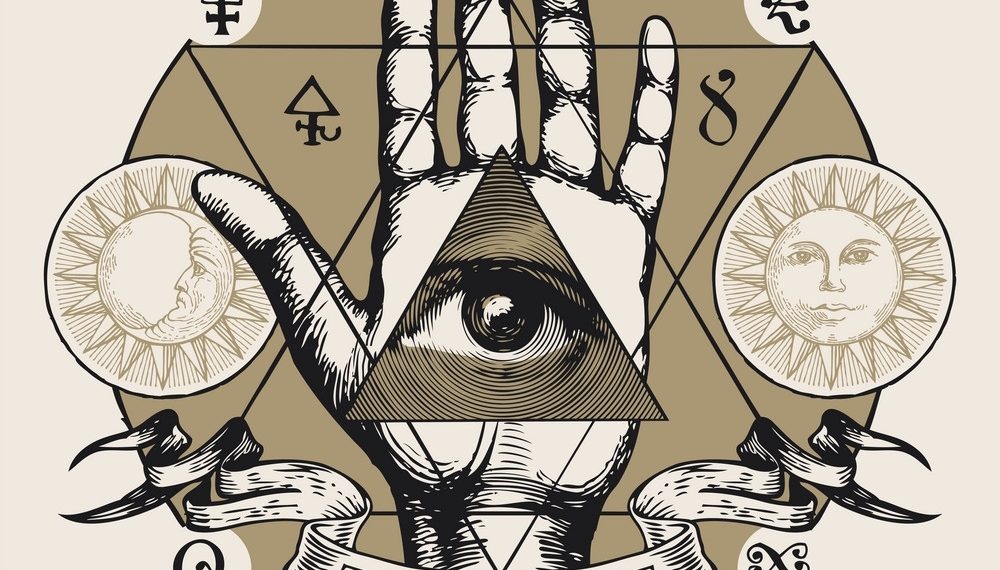“The story of the Temple of Set which you have entered begins in 1966 of what archaeologists, in an effort to be non-sectarian, refer to as the Common Era (CE). In that year a man named Anton Szandor LaVey founded the Church of Satan in San Francisco.
LaVey, an imposing, congenial man with a carnival and circus background, had for many years been an enthusiastic but cynical devotee of the occult. He accumulated a unique library containing many works on the more peculiar and obscure facets of human nature, together with the major classics of traditional occultism. Disappointed with the lack of sophistication and practical relevance he saw in existing occult organizations, he decided that he would have to start one of his own to remedy the problem.
In the early 1960s, therefore, he began to conduct ‘midnight magic seminars’ at his home in San Francisco’s Richmond District. By 1965 these had solidified into a formal ‘Magic Circle.’ The success of this Circle prompted him to found the Church of Satan on Walpurgisnacht (April 30) of 1966, which henceforth became known as Year I Anno Satani (AS).
For the first four years of its existence, the Church remained essentially a San Francisco organization. Group rituals were held every Friday night at midnight at the LaVey residence, while during the week Anton gave lectures on various arcane subjects and taught classes to aspiring Witches and Warlocks.
This fascinating and controversial organization won its share of publicity around the country and abroad, and soon many curious individuals were writing to San Francisco to find out how they too could become Satanists. In 1970 Anton published the Satanic Bible to summarize the basic tenets of his philosophy.
The Satanic Bible did not represent Satan and his fellow daemons as actual ‘supernatural’ beings, but rather as symbols and metaphors for hedonistic self-indulgence. Other religions in general – and Christianity in particular – were not considered to be deadly foes; instead they were mocked and dismissed as sanctimonious and hypocritical frauds.
The Satanic Bible went on, however, to promise results from the practice of simplified and standardized magical rituals. Such rites invoked Satan as well as various other gods and daemons from many mythological traditions, appealing for and/or commanding their aid in curses, seductions, cures, and the like.
There was thus an oddly-inconsistent feature to the Church of Satan’s philosophy: On one hand it professed psychodramatic atheism, while on the other it assumed the literal existence of daemonic personages with the ability to hear invocations and the disposition to respond to evocations.
By 1970 Anton LaVey and his wife Diane had begun to feel the strain of endless hospitality, so a decision was made to cease most of the activities at their home in favor of sponsoring local units or ‘Grottos’ of the Church elsewhere in the United States. From 1971 to 1975 the Church thus consisted of a San Francisco headquarters plus some five to ten Grottos in various metropolitan areas.
Over the years many rumors have circulated concerning the growth and size of the Church of Satan. I have seen figures ranging upwards of 50,000 card-carrying Satanists, with several millions of sympathetic non-members waiting in the wings. In actuality the Church rose from an initial San Francisco membership of about 50 to a nationwide average of about 300 through 1975. There was a turnover of perhaps 30% per year, reflecting the casual, fickle attitude of many of the lower-level members.
By 1973 Grottos had been organized in San Francisco, Santa Cruz/San Jose, Los Angeles, Denver, Dayton, Detroit, New York, Louisville, and Washington D.C. Like the membership-at-large, these tended to be unstable, short-lived groups, surviving and prospering only as long as a charismatic Grotto Leader was in office.
By 1975 Anton LaVey, having presided over nine years of mercurial individuals and Grottos, reluctantly concluded that, while the philosophy of Satanism had lost none of its popular appeal, the Church of Satan itself was largely a failure. A small, stable nucleus of serious and sincere devotees had indeed developed, but for the most part the Church had served to attract merely fad-followers, egomaniacs, and assorted oddballs whose primary interest in becoming ‘Satanists’ lay in being able to flash their membership cards for cocktail-party notoriety. Anton decided that the Church might as well be converted to a vehicle for his personal financial benefit, hence in may of 1975 he announced a decision to sell the Satanic Priesthood and all higher degrees for funds or objects of value.
Upon founding the Church, Anton had claimed for himself the titles of High Priest of Satan and Magus of the Age of Satan. By 1969 he had begun to ordain others to the Satanic Priesthood (the Priesthood of Mendes), and in 1970 he formalized an initiatory structure of five degrees: Satanist I, Witch or Warlock II, Priest or Priestess of Mendes III, Magister IV, and Magus V. Advancement to the II was based upon a fairly elementary examination concerning the contents of the Satanic Bible, but Anton was extremely strict concerning ordination to the Priesthood. Perhaps twenty individuals attained the III between 1966 and 1975, while during the same period Anton conferred only four IVs – one of which upon myself.
Anton’s 1975 decision to sell the degrees confounded the nucleus of sincere Satanists, myself included, who saw in it a critical corruption of the very institution whose incorruptibility and condemnation of hypocrisy had made it so refreshing and exhilarating.
Seizing control of the Church was impossible; Anton had incorporated it under his exclusive, personal control in 1971, a time when none of us had remotely anticipated his 1975 decision. Our only option was therefore to leave. By mid-June 1975, therefore, virtually the entire nationwide Priesthood of the Church had resigned en masse. The Church of Satan as a viable, functional organization was dead, save that the LaVeys continued to use the corporate name and image for private gain as a ‘business partnership,’ a status upon which they formally agreed by contract in 1985.
In 1986 Diane [LaVey] Hegarty sued Anton to dissolve the business and divide its assets between the two of them, and this was so ordered by the San Francisco Superior Court on October 28th, 1991. Anton subsequently filed for bankruptcy for himself and the Church of Satan, and the U.S. Bankruptcy Court so ordered, under the dissolution Chapter 7 of U.S. bankruptcy law, on April 29, 1993. Legally as well as essentially and organizationally, therefore, the Church of Satan no longer exists, though continuing attempts to exploit its name might pretend otherwise.
The other three Masters of the Church had all turned tail in June 1975: One, Charles Steenbarger, was a clinical psychologist in Denver who feared that any but the most furtive involvement would wreck his life and reputation; the second, John Ferro, was a self-acknowledged decadent who could not bring himself to take any stand against Anton LaVey; the third, Anthony Fazzini, was the LaVeys’ chauffer, whose appointment to the IV a few months earlier had itself been a scandal foreshadowing the June crisis.
As the senior initiate among those who resigned in 1975, therefore, I was looked to for an answer as to what to do next. Should we try to form a ‘Second Church of Satan,’ or was the disaster so overwhelming that any such reconstruction would be futile?
In a Working of Greater Black Magick on the night of the North Solstice (June 21-22), I evoked the Prince of Darkness himself. ‘If this is not the end,’ I said, ‘tell us what we may do to continue our Quest along the Left-Hand Path.’
The result of the North Solstice Working was a document entitled The Book of Coming Forth by Night, professing to be a communication from the Prince of Darkness in his original semblance as the Egyptian god Set. The Aeon of Horus and the intermediary Age of Satan were at an end; the Aeon of Set had now Come Into Being as a catalyst for a new evolution of the Elect of mankind. We were charged to found a Temple of Set to replace the Church of Satan, and I – like Anton LaVey before me – was Recognized to the degree of Magus and directed to assume the High Priesthood.
…
In addition to its emphatic stance against the sort of corruption and confusion that had brought about the downfall of the Church of Satan, the Temple of Set differed from its predecessor in a number of ways. The Church had been arrogantly sensationalistic; the Temple was cautiously philosophical. The Church had opened its ceremonies to visitors, reporters, and academic researchers; the Temple’s activities were completely closed to non-Initiates. All degrees in the Church had been conferred by Anton LaVey personally; in the Temple the Recognitions of Adepts II and of the Priesthood of Set III were entrusted to the Priesthood and Masters respectively.
Doctrinally the Temple confronted a number of challenges with which the Church of Satan had never had to deal. First and foremost was the proposition of the very literal reality of Set. Gone overnight was the shaky conglomeration of half-baked anti-Christian daemonology; in its place was a new conceptualization of the Universe which would gradually mature …
The guiding Word of the Age of Satan – Indulgence – had exhorted Satanists to remain satisfied with a hedonistic approach to an admittedly animalistic life. The Word of the Aeon of Set – Xeper – held out the promise of an evolutionary divinity to those intelligent, bold, and determined enough to attain it. From a simple, colorful, and easy-going Church of Satan there had emerged a Temple of Set which was bewilderingly complicated, socially obscure, and impatient with complacency.
During its first four years the Temple of Set maintained an average membership of about 100 Initiates, almost all of whom were former members of the Church of Satan. Membership solicitation was felt to be inconsistent with the esoteric atmosphere of the Temple and the intrinsic dignity of true initiation. It proved to be very difficult, moreover, to institutionalize a philosophy as complex and underdeveloped as ours. No standardized instructional courses were offered, and any sort of ‘enthusiastic but ignorant followers’ climate was quite unacceptable. Hence we weren’t at all certain that it was a good idea to encourage aspirants who didn’t have an a priori working relationship with a Priest or Priestess through a local Pylon.” – Michael Aquino, Black Magic
Copyright © 2021 by Jegtheme.


